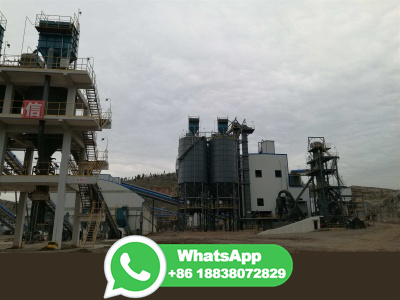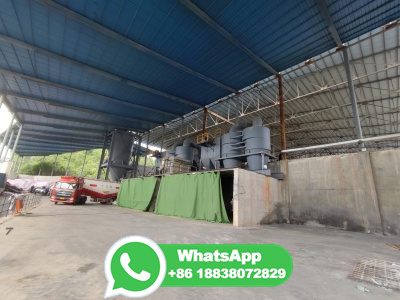
WEBJan 3, 2020 · Coal resources have been used to produce liquid transportation fuels by several process routes collectively referred to as coal liquefaction or, more generally stated, as coal to liquids (CTL). Early records of coal conversion to liquid fuel date to 1913 and an extraction process developed by Friedrich Bergius in Germany [ 7 ].
WhatsApp: +86 18203695377
WEBJun 1, 1987 · The industrial growth of the BergiusBosch coal hydrogenation process in Germany was so successful that throughout World War II when the industry achieved its peak production, the German military's liquid fuel came almost entirely from coalderived petroleum. FRIEDRICH BERGIUS: BACKGROUND TO HIGHPRESSURE COAL .
WhatsApp: +86 18203695377
WEBSep 1, 2017 · In 192225 the Bergius process was demonstrated in Rheinau, which could be deemed a success [35] in that it showed that a continuous process converting coal into oil products was in principle technically feasible, but in the final analysis the Rheinau factory was nothing more than a very expensive pilot plant [33]: two major problems remained ...
WhatsApp: +86 18203695377
WEBVIII. INTERNATIONAL DEVELOPMENT OF THE BERGIUS PROCESS The obstacles that stood in the way of Bergius's promising research on coal hydrogenation were not only technical. Obtaining sufficient research funds proved such a serious problem in postwar, inflationplaguedGermany that by 1920 EVAG had exhausted its entire capital.
WhatsApp: +86 18203695377
WEBBergius shared the 1931 Nobel Prize in Chemistry with Carl Bosch for their contributions to the invention and development of chemical highpressure methods. He is credited with developing the Bergius Process, a method of producing liquid hydrocarbons for use as a synthetic fuel via hydrogenation of lignite coal at elevated temperature and pressure.
WhatsApp: +86 18203695377
WEBBergius Process A process for making lubricants and synthetic fuel petrol from coal by heating a mixture of powdered coal and heavy oil or tar with hydrogen under pressure in the presence of a...
WhatsApp: +86 18203695377![[PDF] Friedrich Bergius and the Rise of the German Synthetic Fuel ...](/au86m23/168.jpg)
WEBOf the several processes the Germans used to convert coal into petroleum, highpressure coal hydrogenation was the most highly advanced. Its history falls into two broad periods:, during which time its inventor, Friedrich Bergius () developed the process through the first stages of industrialization, and, the period ...
WhatsApp: +86 18203695377
WEBEventually if enough plants were built the demand for coal and the availibility of liquid fuels would increase, thus making the whole thing less profitable. It really is a question of the price of coal and alysts versus the price of oil that will influence whether the process is implemented commercially or not.
WhatsApp: +86 18203695377
WEBThe Bergius process was developed by Friedrich Bergius in 1913. In this process, dry coal is mixed with heavy oil recycled from the process. Catalyst is typically added to the mixture. The reaction occurs at between 400 °C (752 °F) to 500 °C (932 °F) and 20 to 70 MPa hydrogen pressure.
WhatsApp: +86 18203695377
WEBFriedrich Bergius. (Chemist) Friedrich Karl Rudolf Bergius was a German chemist known for the Bergius process for producing synthetic fuel from coal. He and Carl Bosch jointly won the Nobel Prize in Chemistry for their contribution in the invention and development of chemical highpressure methods. Bergius and Bosch worked towards developing ...
WhatsApp: +86 18203695377
WEBA process for making hydrocarbon mixtures (for fuels) from coal by heating powdered coal mixed with tar and iron(III) oxide alyst at 450°C under hydrogen at a pressure of about 200 atmospheres. In later developments of the process, the coal was suspended in liquid hydrocarbons and other alysts were used.
WhatsApp: +86 18203695377
WEBThe middle oil is hydrogenated in order to get more gasoline and the heavy oil is mixed with the coal again and the process restarts. In this way, heavy oil and middle oil fractions are also reused in this process. The most recent evolution of Bergius' work is the 2stage hydroliquefaction plant at Wilsonville AL which operated during 198185 ...
WhatsApp: +86 18203695377
WEBmisc{etde_, title = {Friedrich Bergius and the transformation of coal liquefaction from empiricism to a sciencebased technology} author = {Stranges, A N} abstractNote = {This article looks at the work of Bergius, a German research chemist who spent the thirteen years between 1913 and 1926 investigating the conversion of coal to liquid .
WhatsApp: +86 18203695377
WEBThe Fischer–Tropsch process is a chemical reaction, most commonly alyzed by iron or cobalt, in which a mixture of carbon monoxide and hydrogen is converted into a synthetic liquid hydrocarbon. Feedstock for the process is commonly natural gas (gas to liquids [GTL]) or syngas from coal or biomass gasifiion.
WhatsApp: +86 18203695377
WEBSep 15, 2010 · The Bergius process is a simple process for converting brown coal completely into crude oil in the presence of certain alysts. The brown coal is known as lignite. The initial alyst for brown coal has been used as molybdenum oxide in low concentration, along with sulfuric acid to partially neutralize the calcium humates in the .
WhatsApp: +86 18203695377
WEBOther articles where Bergius process is discussed: coal utilization: The Bergius process: The first commercially available liquefaction process was the Bergius process, developed in Germany as early as 1911 but brought to commercial scale during World War I. This involves mixing coal in an oil recycled from a previous liquefaction run and then reacting .
WhatsApp: +86 18203695377
WEBJul 18, 2017 · Coal resources have been used to produce liquid transportation fuels by several process routes collectively referred to as coal liquefaction or, more generally stated, as coal to liquids (CTL). Early records of coal conversion to liquid fuel date to 1913 and an extraction process developed by Friedrich Bergius in Germany [ 7 ].
WhatsApp: +86 18203695377
WEBDec 31, 2009 · By contrast, other variants of the Bergius process require the use of 15 pounds or more of hydrogen per barrel, resulting in an inherent materials cost. Second, the conventional Bergius process requires high pressure, in .
WhatsApp: +86 18203695377
WEBExplanation: the temperature of converter is set to about 350500 0c and a pressure of about 200250 atmospheres where the paste of coal meets hydrogen. the fischertropsch process is carried out at 200300 0c.
WhatsApp: +86 18203695377
WEBWhich type of coal is used in Bergius process? a) Anthracite coal b) Steam coal c) Pulverised coal d) Gas coal View Answer. Answer: d Explanation: Bergius process is used to produce synthetic gasoline form low ash pulverised coal. This coal is finely divided into powder and is converted into a paste. 2. Which substance is mixed with the ...
WhatsApp: +86 18203695377
WEBSep 27, 2019 · The Bergius process allowed the conversion of coals, tars, and other solid or liquid carbonaceous substances into highgrade liquid fuels through the combination of large quantities of hydrogen ...
WhatsApp: +86 18203695377
WEBThe Bergius process for direct conversion of coal to liquids was patented in 1913/1919 [3]. Resources, production and processing of Baltoscandian multimetal black shales.
WhatsApp: +86 18203695377
WEBAug 15, 2007 · Bergius Direct Liquefaction In the early 20th century, German researcher Friedrich Bergius developed a process to directly liquefy coal under high temperature and pressure (coal begins to dissolve above 250 degrees centigrade), and then "crack" the coal molecules into smaller molecules using Bergius termed the process "coal ...
WhatsApp: +86 18203695377
WEBDescribe the principle involved in the synthesis of petrol from coal by Bergius process. Describe the process with a flow diagram. 03:44. View Solution. Bergius process. 03:44. View Solution. Identify the process: Name the process. 02:42. View Solution. Recommended Questions. Bergius process.
WhatsApp: +86 18203695377
WEBThe Bergius process produces hydrocarbon fuel from bituminous coal and hydrogen. The process was first published in 1913 and was an important source of fuel for Germany during World War Two. The process was used in the US for a while after the war, but there are currently no commercial plants in the world. The Bergius process and the Haber ...
WhatsApp: +86 18203695377
WEBThe Bergius process is a method of production of liquid hydrocarbons for use as synthetic fuel by hydrogenation of highvolatile bituminous coal at high temperature and pressure. It was first developed by Friedrich Bergius in 1913. In 1931 Bergius was awarded the Nobel Prize in Chemistry for his development of highpressure chemistry.
WhatsApp: +86 18203695377
WEBJan 30, 2014 · Bergius process for coal liquefaction was patented one century ago. It constituted the first appliion of dispersed phase alysts in slurry reactors, considered as oncethrough disposable from waste materials as additive, the role of alysts in the conversion of heavy carbonaceous feeds like coal of petroleum residues .
WhatsApp: +86 18203695377
WEB2 days ago · In 1912 he devised an industrial process for making light hydrocarbons by the highpressure hydrogenation of coal or heavy oil. The work earned him a share of the 1931 Nobel Prize for chemistry with Carl Bosch (1874–1940). The Bergius process proved important for supplying petrol for the German war effort in World War II.
WhatsApp: +86 18203695377
WEBJun 5, 2018 · Synthetic gasoline can be manufactured byDirect method (Bergius process) and indirect method (Fischer tropsch process)Bergius process. The coal is finely ground and dried in a stream of hot gas. The dry product is mixed with heavy or molybdenum sulphides or tinnickel oblate or iron sulphate present in the coal itself may .
WhatsApp: +86 18203695377